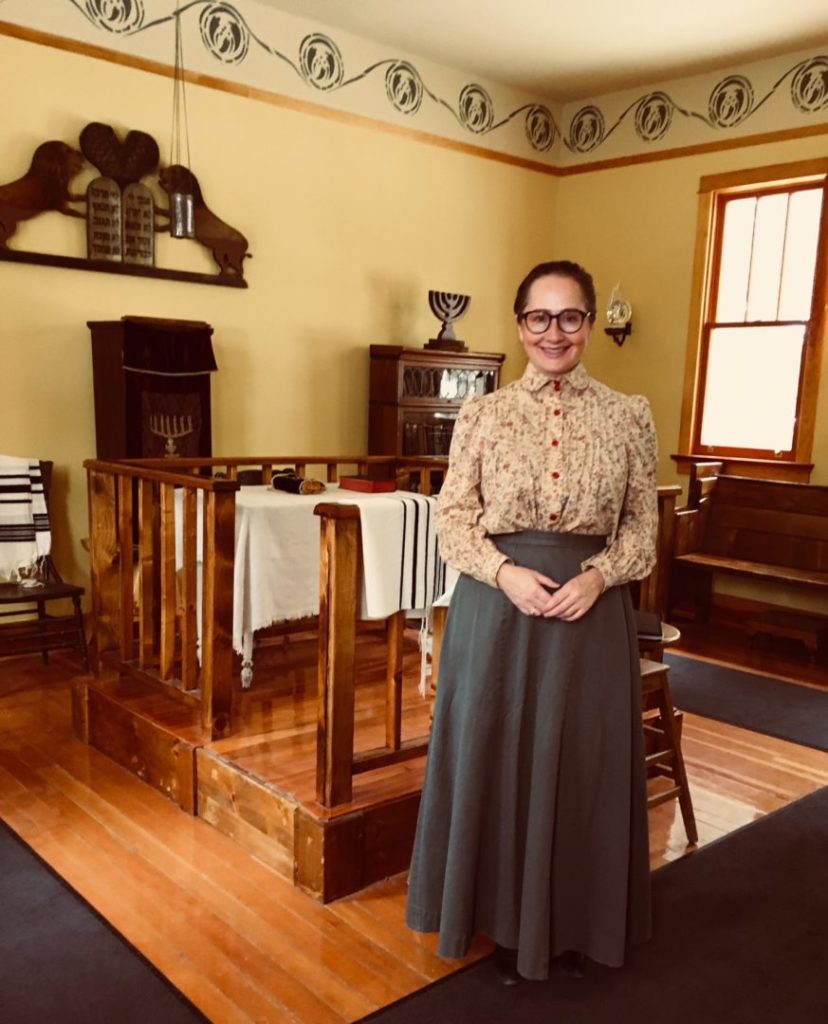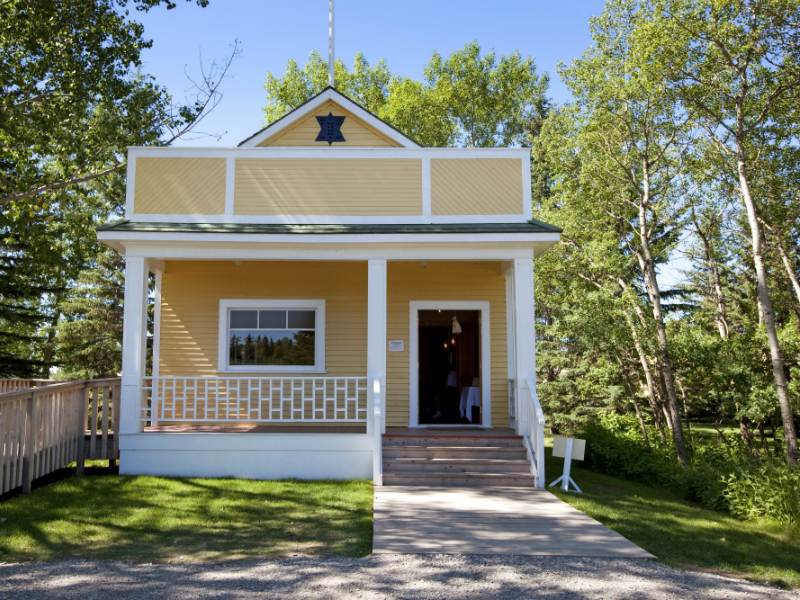Looking back, I can’t believe it’s been 10 years since “the little synagogue” came to Calgary’s Heritage Park Historical Village. It feels like a lifetime ago.
I remember lying awake at night, thinking about how I was going to put a synagogue in Heritage Park. Everything seemed so far into the future. Then, all the things I was hoping to do happened. All the nights, all the emails, all the meetings, all the phone calls, all the begging for money, all the running around is now a blur.
There is a false front, yellow, wooden synagogue at Heritage Park now. It’s one of the last rural synagogues to survive on the prairies and now has the distinction of being the first, and only, one to be included in the permanent collection of any historic park in Canada.
The Montefiore Institute, as it was originally known, tells the story of the early European settlers in Western Canada, including Jews who fled the raging anti-Semitism of Russia and Romania, to the edge of the earth – Alberta. They built their colony and their synagogue in the Palliser Triangle, which covers much of southeastern Alberta and southwestern Saskatchewan.
It was a place where nothing was supposed to grow, yet in the bitter cold and the dry, scorching heat, they managed to turn it into the sprawling farmland that’s visible today. The Jewish people were living on the Canadian prairies from the very beginning, beside the Danes, Italians, Ukrainians, Volga Germans and many others. The little synagogue tells their story.
The Montefiore Institute was built in 1916, was abandoned by the mid-1920s and moved to Hanna, Alta., about 130 kilometres west of its original location, around 1940.
In time, it was sold to private owners, plastered in green and white siding, the porch was covered to create a much-need bedroom for the family’s numerous children, an addition was built in the back and the cutout where the Magen David once looked out into the distant horizon disappeared under its siding. Its transformation into an unassuming bungalow was complete. Its Jewish history was lost from memory. The family that owned it thought they were living in the most
luxurious home they had ever lived in, which they believed used to be a church.
Two generations later, a motley crew of volunteers found the Montefiore Institute and, thanks to the dryness of the climate, it was in perfect condition and would be able to withstand a 230 kilometre ride, on a truck, from Hanna to Calgary.

In June 2008, two years after I emailed my proposal to Heritage Park, I found myself in Hanna early in the morning, watching as a crew of young men removed the synagogue from its foundation. They inserted giant square wooden beams under the structure and rolled them. The building ripped off its foundation and slowly slid onto the truck bed.
None of them were big or stocky or bulky, as one would think they’d have to be for such physically demanding labour. They moved like ballerinas. They were lean, the kind of lean that I’ve encountered in men who have lived difficult lives. How hard they worked! When they were done, we gave them pies, which were purchased at a local bakery, as an expression of our gratitude. It felt shameful. Sure, they got paid for their work, but it felt as though it wasn’t enough.
Hanna got left behind and, for five long months, there was a farm in Strathmore, 50 kilometres east of Calgary, where the synagogue underwent an exterior restoration. The ugly siding was removed and the original structure’s lovely wood was revealed underneath, covered in nail markings. The holes were filled and smoothed and the outside was painted by the restoration crew that drove from Calgary to Strathmore and back, day after day.
READ: BEING A JEW OF COLOUR: FINDING ACCEPTANCE AND INCLUSION
Every time I spoke in public about the project, my voice would crack and a tear would betray me. “What’s wrong with me?” I’d ask myself. I’m not religious. This isn’t even my history, strictly speaking. If one thinks of it as our collective Jewish history, then sure, this is my history. But my family left the Soviet Union in 1978, via Vienna and Rome, and arrived in Calgary in 1979. Those homesteaders came from Russia and Romania in 1910. Perhaps my soul knows something my head does not.
People thank me for loving history, but I’m not sure I do. I think I took one history class in university, and it was boring. I love ideas, projects, adventure and a good story. I love to create things, to work with people and to get to know the people I’m working with. That’s what this project was about for me. It was about creating beauty in the world.
* * *
In November 2008, the little synagogue was finally on its way to Calgary, escorted by an electrical crew. Whenever its path was obstructed by overhead wires, it would slow down, the electrical crew would raise the wires and the building would slowly pass underneath. Imagine a little yellow synagogue racing down the highway. Very cute.
It came to a stop by a farm on the outskirts of Calgary because it would have caused too many traffic problems if it were to travel through the city in the middle of the day. So we went home and waited till nightfall. I was scared that some kook might burn down our precious jewel. Late that night, our baby made its final journey through the city, flanked by television crews. It was quite the sight.
The little synagogue arrived at Heritage Park at 4 a.m. Our crews went to Denny’s for breakfast, as none of the Heritage Park staff were up that early to accept our gift. We warmed up, filled our bellies and returned to the park, where we were greeted by park administrators who graciously accept it. The little synagogue was driven into the park and placed on its foundation.
After that came another long winter, during which I was constantly begging for money. All the while, the benches were crafted, the bimah was built and the mezuzot were carved. As all of this was happening, the grand opening was being organized.
There was no time for me to go grocery shopping, no time to trap the dust bunnies hopping all over my floors. There was no time for anything other than the grand opening.
“We’ll get a thousand people at the opening,” I told my board and opening committee. They told me that I was crazy. “Six hundred, 800 max,” they said. “No, we’ll get a thousand,” I argued.
The speech got written and rewritten over three months. I bought my dress and was loaned a choker festoon necklace and a vintage looking handbag. I caved and purchased a $400 hat.
There were people all around, working hard, doing this and that. But on the Thursday before the grand opening, everything stopped. I could hear the silence. I had nothing to do that weekend, except show up at the grand opening celebration on Sunday, June 28, 2009. We ate burgers at a park the night before. The air had the sweet smell of flowers in it.

On the day of the grand opening, my mother helped me get dressed and we had lunch at Heritage Park. The crowds started coming and coming. In the end, 2,000 people showed up, maybe more. They sang and clapped and people could be seen with tears in their eyes. Very important people gave speeches. My voice cracked again when I gave my speech. My soul knows something my head does not.
Irena Karshenbaum is the founder, and served as president, of The Little Synagogue on the Prairie Project Society, which gifted the historic Montefiore Institute to Heritage Park Historical Village in Calgary. She will be attending the 10th anniversary celebration at the park’s Railway Orientation Centre on Aug. 5 at 11 a.m. Admission is free.
